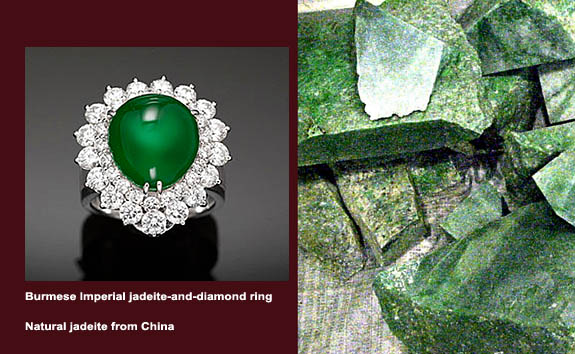When Continents Collide: Ruby And Jadeite Reveal Secrets About The History Of The Earth
By: Kelly York
An international team of geoscientists report that the formations of ruby and jadeite are clear indicators of two types of continental collisions that changed the topography of Earth millions of years ago.
 Ruby, they say, is formed in the places where two continental plates collided, such as Central Asia. The tallest mountains on Earth, like the Himalayas, resulted from slow-motion continental collisions that created the heat and pressure needed for ruby to form.
Historically, East Africa, southern India and Madagascar were home to mountain ranges that are now sources of rubies, according to a research team lead by Robert J. Stern of the University of Dallas. The research team reported its findings in the journals Geology and Earth and Planetary Science Letters.
Ruby, they say, is formed in the places where two continental plates collided, such as Central Asia. The tallest mountains on Earth, like the Himalayas, resulted from slow-motion continental collisions that created the heat and pressure needed for ruby to form.
Historically, East Africa, southern India and Madagascar were home to mountain ranges that are now sources of rubies, according to a research team lead by Robert J. Stern of the University of Dallas. The research team reported its findings in the journals Geology and Earth and Planetary Science Letters.
 Jadeite, (the most precious variety of jade) is formed by subduction – where an oceanic plate slides under a continental plate and sinks into the Earth’s mantle. Jadeite is most commonly found in Myanmar and Guatemala, from subduction before India and Asia collided, and subduction between the North America and Caribbean plates.
In some subduction zones, the interaction between the mantle, fluids and subducted oceanic sediments creates jade, but Stern asserts that “Not all subduction zones get jade, and not all continental collisions get ruby.”
Armed with the ruby and jadeite markers, geologists can better understand how the continents formed and make more accurate assumptions on where new sources of the precious gemstones may be found.
Jadeite, (the most precious variety of jade) is formed by subduction – where an oceanic plate slides under a continental plate and sinks into the Earth’s mantle. Jadeite is most commonly found in Myanmar and Guatemala, from subduction before India and Asia collided, and subduction between the North America and Caribbean plates.
In some subduction zones, the interaction between the mantle, fluids and subducted oceanic sediments creates jade, but Stern asserts that “Not all subduction zones get jade, and not all continental collisions get ruby.”
Armed with the ruby and jadeite markers, geologists can better understand how the continents formed and make more accurate assumptions on where new sources of the precious gemstones may be found.
 Visit Ben David Jewelers on Facebook
Visit BenDavidJewelers.com
Visit Ben David Jewelers on Facebook
Visit BenDavidJewelers.com
 Ruby, they say, is formed in the places where two continental plates collided, such as Central Asia. The tallest mountains on Earth, like the Himalayas, resulted from slow-motion continental collisions that created the heat and pressure needed for ruby to form.
Historically, East Africa, southern India and Madagascar were home to mountain ranges that are now sources of rubies, according to a research team lead by Robert J. Stern of the University of Dallas. The research team reported its findings in the journals Geology and Earth and Planetary Science Letters.
Ruby, they say, is formed in the places where two continental plates collided, such as Central Asia. The tallest mountains on Earth, like the Himalayas, resulted from slow-motion continental collisions that created the heat and pressure needed for ruby to form.
Historically, East Africa, southern India and Madagascar were home to mountain ranges that are now sources of rubies, according to a research team lead by Robert J. Stern of the University of Dallas. The research team reported its findings in the journals Geology and Earth and Planetary Science Letters.
 Jadeite, (the most precious variety of jade) is formed by subduction – where an oceanic plate slides under a continental plate and sinks into the Earth’s mantle. Jadeite is most commonly found in Myanmar and Guatemala, from subduction before India and Asia collided, and subduction between the North America and Caribbean plates.
In some subduction zones, the interaction between the mantle, fluids and subducted oceanic sediments creates jade, but Stern asserts that “Not all subduction zones get jade, and not all continental collisions get ruby.”
Armed with the ruby and jadeite markers, geologists can better understand how the continents formed and make more accurate assumptions on where new sources of the precious gemstones may be found.
Jadeite, (the most precious variety of jade) is formed by subduction – where an oceanic plate slides under a continental plate and sinks into the Earth’s mantle. Jadeite is most commonly found in Myanmar and Guatemala, from subduction before India and Asia collided, and subduction between the North America and Caribbean plates.
In some subduction zones, the interaction between the mantle, fluids and subducted oceanic sediments creates jade, but Stern asserts that “Not all subduction zones get jade, and not all continental collisions get ruby.”
Armed with the ruby and jadeite markers, geologists can better understand how the continents formed and make more accurate assumptions on where new sources of the precious gemstones may be found.
